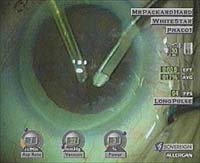WhiteStar phaco reduces burn potential, surgeon says
Using a bimanual technique, one surgeon reports performing small-incision cataract surgery safely.
WINDSOR, England — WhiteStar technology was found to improve safety, efficiency and control in cataract surgery during bimanual phacoemulsification with a sleeveless phaco tip, according to Richard B. Packard, MD, FRCS.
Dr. Packard discussed his experiences with minimal-incision cataract surgery using WhiteStar technology to enhance the Sovereign phacoemulsification system (Advanced Medical Optics).
“My surgery results have been very good,” Mr. Packard said. “With WhiteStar, I can create 1.1-mm incisions and use a sleeveless phaco tip without causing wound burns. Also, I can work bimanually, which because of tight wounds without leakage, improves fluidics.”
Mr. Packard has been using White-Star technology with the Sovereign system for 18 months. The WhiteStar system is a technology enhancement program that controls the way phaco energy is delivered by the Sovereign system.
WhiteStar alters the phaco stream by breaking it up into a series of extremely rapid pulses. These alternate between bursts of ultrasonic energy and rests when no power is generated, Mr. Packard said.
The phaco and rest pulsing thus produced reduces the amount of heat energy generated and cools the tip of the phaco handpiece.
“This prevents the tip from overheating and thus producing wound burn. As a result of this technology, research has shown that burns are a thing of the past,” he said.
|
|
Less energy, less burn
According to Mr. Packard, conventional phaco using even burst or pulsed ultrasound settings can cause wound temperatures to rise significantly to produce wound burns. Conventional phaco, whether continuous or pulsed, causes repulsion of nuclear fragments and thus inefficient phaco power usage.
“WhiteStar, by allowing rests between ultrasound bursts and due to the very rapid pulsing, produces efficient cutting as required and no repulsion or heat generation,” he said.
However, WhiteStar can control and vary the ratio of bursts of ultrasound energy to rest so that different settings can be used for sculpting and nuclear fragment removal. When using WhiteStar, the lack of repulsion means the pieces of nucleus seem to stay in close proximity to the phaco tip and are thus removed more easily.
According to Mr. Packard, studies have shown that it is “virtually impossible” with WhiteStar to heat up a phaco wound to a level where a wound burn would result.
In a study on cadaver eyes conducted at the University of Utah, researchers found that wound burns could not be produced at the highest WhiteStar energy setting unless all flow and aspiration into the eye was occluded for a few minutes.
Additionally, the study showed that the temperature at the wound did not rise above 37°C when continuous phaco was applied with the WhiteStar technology.
Tight incision improves fluidics
The reduced threat of wound burn enables surgeons to perform surgery without a protective sleeve on the phaco handpiece, Mr. Packard noted.
“As the tip doesn’t heat up, you can do bare-needle phaco through a 1.1-mm incision. This way you get a very tight wound,” he said.
In conventional cataract surgery, Mr. Packard said, his typical incision is approximately 2.5 mm in length.
“With a 1.1-mm incision, you have an almost perfect chamber with no wound leakage,” he said.
Bimanual improves control
Mr. Packard’s technique with White-Star is enhanced with an instrument he developed specifically for the surgery.
“With the help of Duckworth and Kent, I designed an irrigating chopper that fits through a 1.1-mm incision opposite the phaco needle,” he said.
The need was to have an instrument with sufficient flow to maintain the anterior chamber and also be maneuverable enough to carry out an efficient, easy vertical chop, he said.
The irrigating chopper cuts down onto the piece of nucleus held on the phaco tip with high vacuum, and the phaco tip is then moved away to create the crack. A stable chamber is maintained due to the good flow rate through the chopper and the minimal leakage. The lack of wound healing means it is possible to crack mature cataracts, which can often be problematic during conventional phaco surgery without WhiteStar.
Currently, Mr. Packard is implanting IOLs during surgery through an enlarged incision of 2.75 mm.
“For now, we still have to implant the IOLs through conventional incisions,” he said.
However, several IOL companies are developing lenses that can be inserted through smaller incisions like the 1.1-mm incision used in sleeveless phaco.
“Once smaller lenses that perform as well as current IOLs are developed to fit through 1.1-mm incisions, the technique will be even more successful,” Mr. Packard added.
For Your Information:
- Richard B. Packard, MD, FRCS, can be reached at HRH Princess Christians Hospital, 12 Clarence Road, Windsor, England SL45AG; +(44) 175-382-92204; fax: +(44) 175-38-31-185; e-mail: eyequack@vossnet.ico.uk. Mr. Packard is a paid consultant for Advanced Medical Optics.
Reference:
- Advanced Medical Optics, makers of WhiteStar Technology for the Sovereign System, can be reached at 1700 E. St. Andrews Place, Santa Ana, CA 92799 U.S.A.; +(1) 714-247-8200; fax: +(1) 246-4297; Web site: www.amo-inc.com.
- Soscia W, Howard JG, Olson RJ. Microphacoemulsification with WhiteStar: A wound-temperature study. J Cat Refract Surg. 2002;28:1044-1046.


